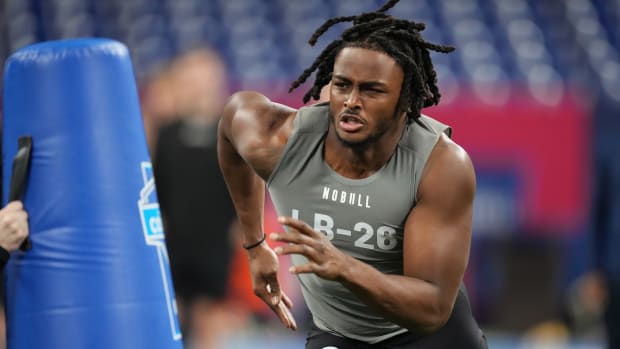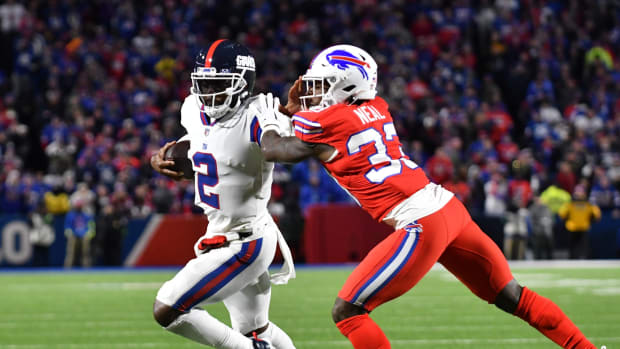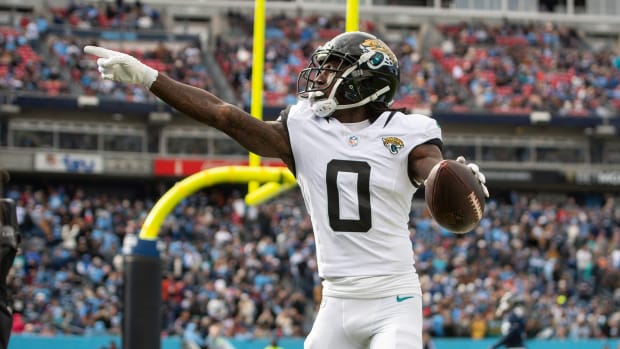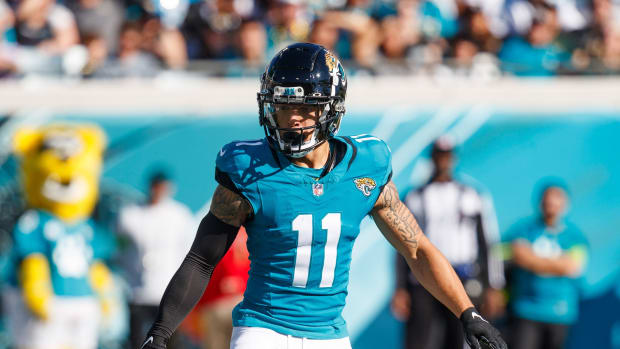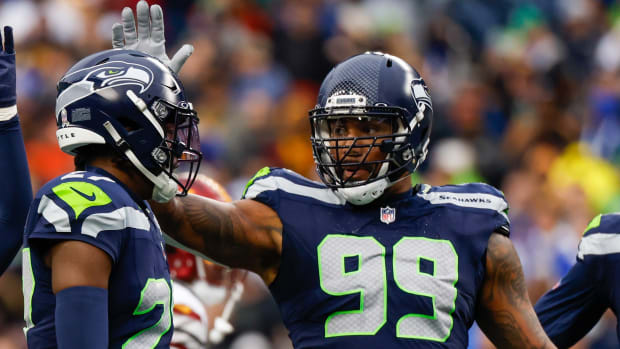Out From the Dark: Sam Shields’ Two-Year Journey Back from Concussion
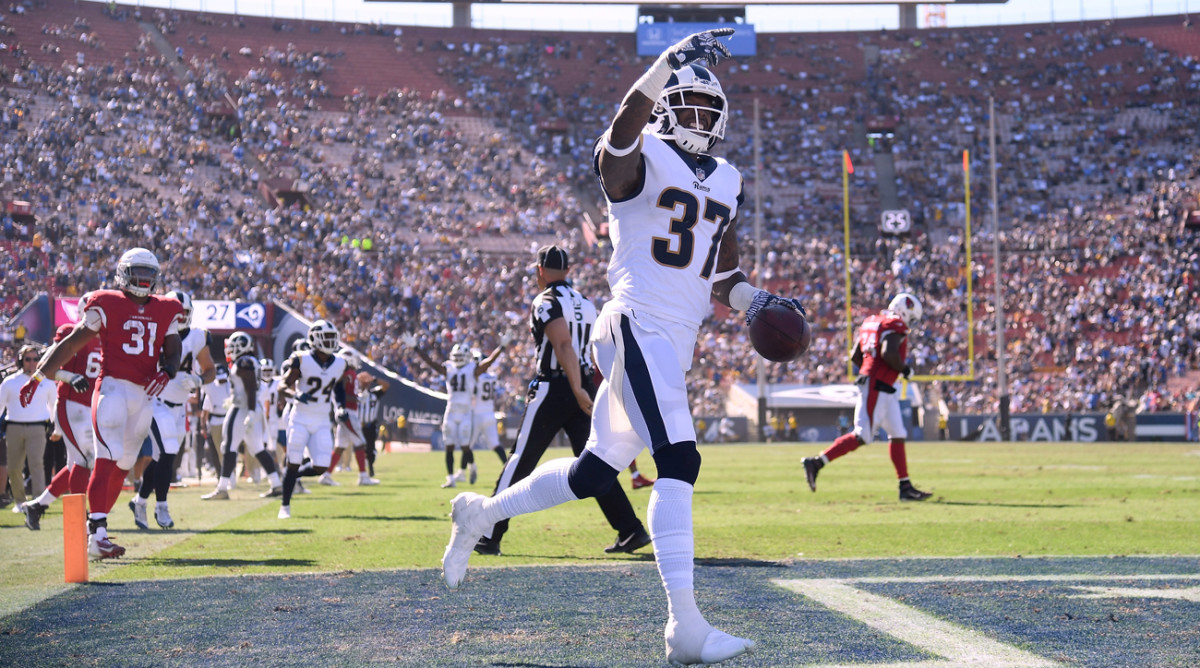
The Riddell “Speed” helmet that Sam Shields prefers measures a little more than two inches thick, from its blue exterior shell to the inflated pads that touch his scalp. This membrane of polycarbonate alloy, foam and polyurethane, plus pure dumb luck, are all that stands between the 31-year-old Rams cornerback and a head injury like the one that turned his life inside out two years ago—the one that turned sprinting outdoors for a living into lying indoors every day; that changed feeling invincible all the time into feeling weak and vulnerable; and that traded pursuing his life’s passion for shopping online for opaque curtains and trying in vain to sleep.
And yet there he was, all season long, snapping his chinstrap and lining up as a gunner on the Rams’ punt team, answering the call to cover Stefon Diggs or Tyreek Hill when needed, clacking his helmet against someone else’s a few times each Sunday. With every snap that Shields plays for the Rams, he knows he’s risking the return of the uninterrupted headache he endured every day for fourteen months, whose only hint of relief came “when I was still, calm, and in the dark.”
Yet there he is.
“I haven’t seen anything like it,” says Wade Phillips, L.A.’s 71-year-old defensive coordinator. Phillips got his first NFL coaching job eleven years before Shields was born, and he can’t think of another player who returned to the sport after a 700-day hiatus caused by a hit to the head. “I mean, there’s been guys who have been out for a while, but it’s because they weren’t particularly good players. When they put the pads back on it’s a neat story. But this is a really good player we’re talking about. And he was gone for two years.”
The story of Shields’ return features a renowned medical team that didn’t know what he did for a living. Its soundtrack is the din of two conch shells being pressed to his ears in time with his pulse— the sound of Shields’ 14-month headache. It stars a protagonist who just a few months ago had “given up on football entirely,” but now finds himself in the 2019 playoffs for the NFC’s No. 2 seed.
The story begins with a hit that looked like it shouldn’t have injured anyone.
The Packers were in Jacksonville on Sept. 11, 2016, leading the Jaguars 27-23 late in the fourth quarter, when Jags running back T.J. Yeldon carried off left tackle for a two-yard gain. It’s football’s most common play—picks up one, maybe two, the broadcaster usually says. Shields had done his duty, as he’d done hundreds of times in his six-year career, advancing from his cornerback position and throwing his shoulder into Yeldon to stop the 218-pound ballcarrier near the line. Only this time Packers D-lineman Letroy Guion had slammed into Yeldon from the other side just as Shields delivered his blow.
It wasn’t the violence of Shields’ impact with Yeldon that hurt him. It was the 320-pound wall that showed up behind Yeldon from out of nowhere. Shields’ 184-pound body—most importantly, his brain—had nowhere to go.
It happened in less than a second, the violent sloshing of Shields’ brain into the left side of his skull, then back to the right, then back to its home position. As everyone else got up from the pile, Shields remained face down on the grass for five seconds. When he rose, Morgan Burnett, Shields’ friend and teammate of six years, sensed something amiss and steered him toward the sideline for a couple of steps before Shields took over and jogged off by himself. He didn’t stumble or swerve on his way to the tunnel.
“Right afterward I was fine,” Shields said a few weeks ago, reclining in the Rams’ special teams room. “I don’t know if it was the adrenaline or what, but as soon as I got in the locker room I almost fell down. Headache. It was like a heartbeat. Constant.”
Shields hid the effect of the blaring conch shells as he greeted his parents and daughters after the win. “He seemed fine,” his dad, Sam Jr., recalls. “We even took some photos with him.”
No one knew that Shields would sit out the next 31 regular-season weekends, pursuing relief from his merciless headache instead of pursuing the game’s swiftest players.
He had done everything right on the Yeldon tackle. Hips low, shoulder first, head to the side. The randomness of the injury—that little white roulette ball hopping around the wheel and settling in the wrong spot, due not to any bad actions on Shields’ part—might have frustrated a less-experienced player. But Shields knew all about fate’s fickle hand. Six years earlier, that same hand had nudged an undrafted rookie into the starting cornerback job in Green Bay and then toward the game-clinching interception in the 2011 NFC Championship Game and a Super Bowl ring.
Shields knew about skinny windows and bad odds. He hardly had a chance to catch the grown-man passes his dad fired at him when he was a kid. Starting at age five, Shields’ dad would place him in their backyard in Sarasota, Fla., turn the boy’s back to him, walk a few paces, then slap a football and unleash a spiral at the spot where the kid’s face would be when he finished a 180-degree spin.
Call up Shields’ career highlights and look at his 19 interceptions. Each one, including the one he snagged against the Cardinals in September of this season (his first pick since 2015) was caught with his arms extended, elbows nearly locked. “My dad would throw it so hard that if I tried to catch it like this,” Shields says, cradling an invisible ball to his chest—“it would hit me in the face.”
“Pain,” Shields adds, “can be a teacher.”
Pain. In the immediate aftermath of Shields’ 2016 injury, every contraction of his heart brought a fresh wave of it to the inside of his skull. Day after day. “The Packers gave me balance tests and computer tests,” he says. “I failed them all. I couldn’t concentrate on the computer for longer than two minutes. I couldn’t balance. They kept sending me home.
“It was winter, I was cold, I wasn’t playing, I was miserable. So I was just going home and—s---, getting high. That was the only way I was gonna cope with it. I could eat better, sleep better [after smoking cannabis] … I’m not saying it’s always good. But it helped me get through some things.”
As the Wisconsin winter deepened, and the 2016 NFL season continued without him, Shields, unmarried and alone, stayed indoors in near darkness. The brightness of his iPhone screen was unbearable. His was the life of a mobster in prison: He had a sweet pad, with every amenity, but not being able to leave is still not being able to leave. So he went home to Sarasota. If he was going to be quarantined, he at least wanted to be near his girls.
“I got three baby mamas,” Shields says with none of the shame that our society expects to accompany such a statement. “After the Atlanta playoff game [January 22, 2017] that’s when they cut me. That’s when I went in the tank. I just had my family and my kids to keep me going.”
His daughters, Sammyla, 11, and Sanii and Emme, both nine, didn’t care about his decision to quit football. “They were just happy I was home,” he says. “‘Daddy’s home! Can you take me to school tomorrow?’
“I was able to do all those things that I missed. Birthday parties for my little nieces, for my mom, for my daughters, I was there for all of it. Family graduations. I loved the s--- out of it. I wasn’t even thinking about football.”
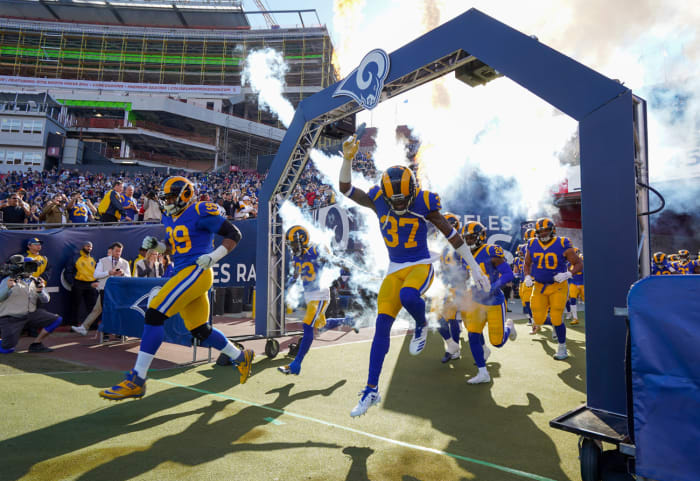
Entering the field with Aaron Donald for the season finale.
Scott Varley/Digital First Media/Torrance Daily Breeze via Getty Images
“He spent most of his time with his mom,” says Shields’ dad. “They’d go shopping together, do things together … When he was with me he had his chest out. It’s like that with dads, you know. His chest was out. ‘I’m doing good, I’m doing fine.’ ”
But at home, drawn blinds and silence remained the rule. “A lot of people don’t understand—being in the house, just mentally, I could have lost it.” Shields manages a laugh. “Seriously! That s--- is real! … I didn’t know what to do because [the headaches] wasn’t stopping. The pills weren’t working.”
Asked about his son’s lowest point, Sam Jr. pauses 30 seconds before answering. The sounds of a proud man trying not to let his emotions overtake him leaks through the phone line. “The night he asked his mom to come over,” he says.
“It was three o’clock in the morning on some night in January 2017,” Shields wrote for the Players’ Tribune earlier this season. “It felt like my brain was cramping, or like it was trying to break out of my skull or something. I was rolling around in my bed, whipping my body back and forth, trying to escape the pounding inside my head. Next thing I know, I’m curled up in the fetal position, shaking and crying.”
So he called his mom. Michelle Shields, Sam Jr.’s wife of 33 years, came over, made soup, and rode it out with him. But Shields knew that more nights like that one lay ahead.
It had been a good run. Seven years. A ring. A trip to Hawaii for the ’15 Pro Bowl. He’d earned more than $30 million. The end of his career was no tragedy. Letroy Guion beat his man and hit T.J. Yeldon at the same time Shields did, the white roulette ball stopped in the wrong little square, and now Shields was paying up on a bet he had made willingly, years earlier, when he first suited up for the Ringling Redskins Pop Warner team.

Undrafted out of Miami in 2010, Shields won a Super Bowl ring with the Packers as a rookie. This weekend will be his 11th postseason game.
Harry How/Getty Images
But then, not long after the night his mother brought him back from the brink, he found himself on the phone with a friend in Los Angeles. “She said, ‘You need to come to UCLA, they’ve got the best neurology rehab thing going on,’ ” Shields recalls. “This was the time, in my mind, I was done. I was like, f--- football, I just wanna be with my family.”
When Shields booked his flight to L.A., he didn’t do it because of football, he says. “It was them headaches, man.” Was his brain going to pound like this forever? Would he watch his daughters grow up through eyes squinted in pain?
Dr. Christopher Giza, director of UCLA’s Steve Tisch Brain Sports program, declined to discuss Shields’ case, citing patient confidentiality, unless Shields agreed in writing to waive his right to privacy. Shields signed the documents as soon as a Rams PR staffer passed them along to him. “I want people to know what happened,” Shields says.
Freed up to talk, Dr. Giza explains that most concussion treatments “are focused on the first four weeks after the injury: monitoring symptoms, avoiding re-injury, engaging in a modest level of activity, and just letting time pass. That kind of management doesn’t tend to work when you are outside that four-week gap.”
Shields walked into UCLA 26 weeks after he tackled T.J. Yeldon. He had hardly exercised at all during that time. Which is why it’s important to note, as Giza does, that a normal adult’s response to exercise “can overlap with the symptoms of concussion. Headache, fatigue, dizziness.”
In other words, when you’re as far removed from the concussion-causing incident as Shields was, and you’ve hardly broken a sweat during those six months, you have to discern whether the discomfort you feel when exercising is related to your head injury or simple lethargy. When athletes don’t make this distinction, Giza says, “they can become unduly worried that the concussion is ‘coming back.’ We don’t want patients to sort all this out on their own. But that’s what was happening with Sam.”
The first thing Giza’s team did, after evaluating Shields and conducting introductory interviews, was put him on a stationary bike, with wires reporting his vitals. As Shields pedaled, a member of Giza’s team, which included a sports neuropsychologist and a cognitive behavioral therapist, sat next to him “and asked me a thousand questions,” Shields recalls. The questions weren’t about how Shields was feeling as much as how he felt about how he was feeling.
“They asked me, ‘Sam, what if your headaches were gone [and] what if you go out on the field again and you ding your head, would you automatically assume it was a concussion?’ ”
Another query: When your headache intensifies during exercise, does that frighten you?
Asking Shields to consider these questions about his brain had the added benefit of knocking the cobwebs out of its corners with a broom. Giza told him, “Your brain is like a muscle—you gotta work it,” Shields says. “He said by sitting in the dark, I was killing my brain. Not challenging it. Not talking to anybody. Just making it worse.”
“One of the biggest challenges that the public and media face right now [regarding concussions],” says Giza, “is kind of a microcosm of our political world. People listen to the extreme … so you hear that everybody who gets a concussion is doomed and has a risk of developing CTE or dementia. Or the opposite side, which is the more traditional side from 20 years ago: ‘Well these injuries are just bonks on the head, they’re not really something to worry about.’ It seems like people take up their camp on either side, and then they sort of interpret the research to conform to what their pre-existing ideas are.
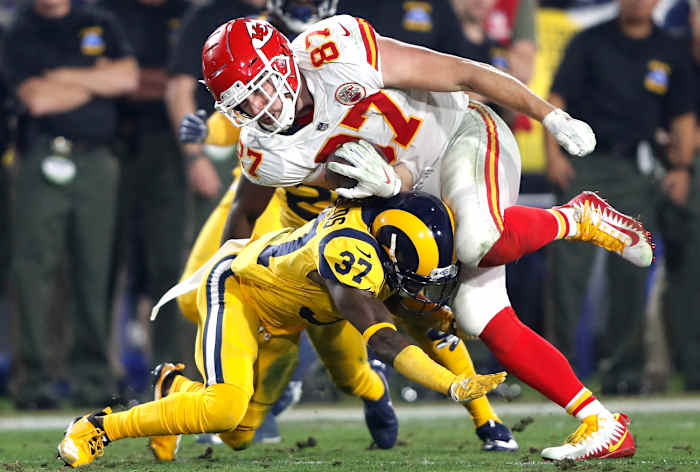
Shields goes all in on a tackle of Travis Kelce in the Chiefs game in Week 11.
Sean M. Haffey/Getty Images
“In reality, the truth is in between. I often refer to concussion and traumatic brain injury as the most complex injury to the most complex organ. To think that there’s a little checklist or formula that’s going to work for everybody—it doesn’t do justice to how complicated and individualized this injury can be.”
When Shields began his treatment at UCLA, hardly anyone on Giza’s team knew what Shields used to do for a living. Giza only knew that “the patient had a history of head injuries [whose] main symptoms were intractable headaches that affected him on a daily basis.” (“We didn’t know he had chosen to go back to football until you reached out to us,” Giza told SI in November.)
Treating Shields was a novel experience. “Some athletes come in, and their thing is, ‘I need to return by this date, because this is when tryouts are,’ ” says Giza. “That isn’t the impression we got from Sam. He just wanted to get healthy.”
When Shields wasn’t at UCLA, “he was doing homework,” Giza says—riding a bike or an elliptical machine at his AirBnB, nearby. When Shields returned to the clinic, Giza increased, ever so slightly, the volume and intensity of his exercise. “Meanwhile, some of the interventions we’d made with the headaches were kicking in,” Giza says. Like taking Shields off the Tylenol he’d been popping like TicTacs since the end of the Obama administration.
Football?
“The doctors said, We don’t care about that,” Shields recalls. “They were loving the situation that they was in. Because they was learning from me. It was an enjoyment to them. We became like a family, damn near.”
Knowing when an athlete has completed his treatment, Giza says, “is very individualized.” Giza tells a quick story about a pro basketball player who went through a process similar to Shields’ and “thought he was ready,” until he went to a gymnasium for the first time and “nearly had a panic attack.”
At this point, Shields still wasn’t interested in returning to football. But then the headaches became intermittent instead of constant. A couple per week instead of one unrelenting one. He was a few weeks shy of 30. He started to think about what he could give a team, just on special teams. He thought about the feeling in an NFL locker room, the post-practice smell of sod and sweat. The jokes, the art of playing them off when they’re aimed at you, and the way the sharks circle when vets discover a teammate with thin skin. And yes, he thought about the money.
“I can still run,” he thought. “Why not?”
Whether it was wise for Shields to drop that white pebble onto the black and red wheel again—only one man can make that call. Shields makes a strong argument that what football provides his family in terms of financial stability is worth the 14-month headache he endured, and any medical problems he might incur down the line, too.
In the middle of the 2017 NFL season, as Shields’ six-month treatment at UCLA wrapped up, he decided to consult three more experts. “I said to my homeboys, if I ask my kids if they want daddy to go back [to football] and they say yeah, I’m going back. If they say no, I’m not.”
To his surprise, his daughters screamed in delight at the mention of it. Shields didn’t ask the younger two to explain their reasons, but he probed deeper with his oldest, 11-year-old Sammyla. “She said, ‘Because I like watching you play, Daddy.’
“That’s real.”
The Rams expressed immediate interest, along with the Browns. “Since I’ve been coaching we’ve had our eye on Sam,” says head coach Sean McVay. “Our safeties coach, Ejiro Evero, coached him in Green Bay. Couldn’t say enough good things about him.”
“He was one of the best, if not the best, man-to-man players in the league a couple years ago,” says Phillips, the white-haired defensive coordinator. “Everybody knew about him.”
In the spring of ’18, the Rams invited Shields to a one-man tryout in Los Angeles. Cornerbacks coach Aubrey Pleasant, who usually likes to throw unexpected drills and demands at free agents to see how they adapt to discomfort, says he handled Shields differently. “I wanted to give Sam respect and say, Hey we’re gonna put you through some movements, see what you have, but we’re not gonna kill you.”
Shields’ cleats tapped the turf, planting and cutting on command. Footballs whistled at him. His elbows straightened and his hands stopped them cold and cradled them to his ribs.
“Man, he looked exactly like he always did!” McVay recalls with his trademark intensity. A contract was drawn up that afternoon.
Now Shields just needed to make the team.
“If you’re good at running punt [coverage], you can make all 32 teams if you want to,” Shields says. “So I went to the special teams coach [John Fassel] and I said, ‘Listen, whatever you need me to do, I’m willing to do it, I’m ready. I appreciate this opportunity.’ ”
“What he’s been doing on special teams,” says Pleasant, “to me that is the ultimate show of selflessness. For him to play in a Pro Bowl, be the best of the best, and then come back and start as our gunner, I think that says a lot.”
Re-mastering his main craft, though—covering people—“that part was tough,” Shields admits. “I was off. I’m talking about off.” Working against the Rams’ offense didn’t make things easier.
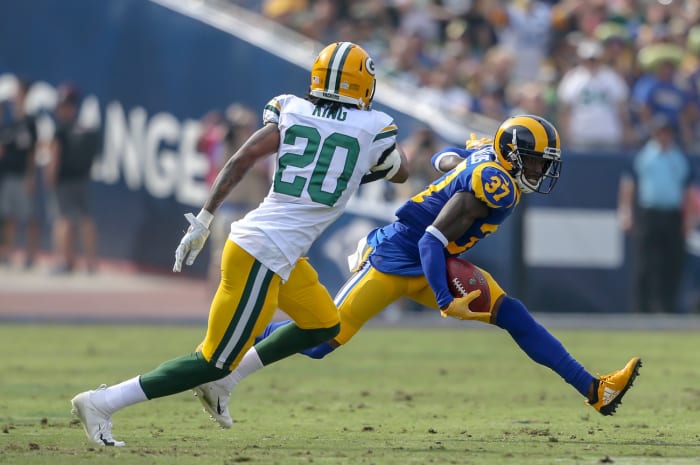
Against his old team in Week 8, Shields had his first career reception, gaining 12 yards and a first down on a fake punt.
Jevone Moore/CSM/REX/Shutterstock
“I was from the NFC North, where there’s a lot of West Coast offense. Then this?” As quarterback Jared Goff ran through a training-camp script of fake jet sweeps, elaborate route combinations and sneaky pitchouts to the reigning MVP, Todd Gurley—sometimes all on the same play—Shields responded, “Oh, shit, what the hell is going on here?
“But each day I was getting better. I wasn’t getting worse.”
Shields was thrust into a more prominent role when starting corner Aqib Talib underwent ankle surgery three weeks into the season. Shields ended up playing an unexpected number of snaps at corner this year—343—which also increased his odds of taking a shot to the head. McVay and his staff kept close tabs. “You care about all these guys,” says McVay, “but with him you’re a little more sensitive. He banged his shoulder against Seattle [in Week 5], and he was down, just holding it, and our immediate reaction was, ‘Oh gosh.’ ”
Shields, who was recently named the Rams’ recipient of the Ed Block Courage award, has played in 96 NFL games in his career and made 265 tackles. How long does he want to keep doing this?
“Three years,” he says without pause. “I wrote on a piece of paper when I was in high school: 10 years in the league. That has always been my goal … I got a few Dunkin Donuts franchises with my partner, [Lions defensive lineman] Ricky Jean Francois. I’ve been putting my money in the right spots. I played in Green Bay so I haven’t spent s---,” he says with a laugh. “You can’t spend any money in Green Bay.
“I just know that around that time—10, 11 years—my kids’ kids will be good.”
His dad, when asked if there’s a moral to this story, says, “Time does heal. And I think a lot of guys that play this game—you do need to take some time off.” Then Mr. Shields gets to talking about his granddaughters again, which makes him tear up a little again, and reminds him of that scene in the backyard, 25 years ago, with his namesake.
“I remember having him run around the house. I’d be on one side of the house, and when he comes around the corner he doesn’t know the ball is coming. He’d hear my voice—I’d say, Come, and he’d come and I’d throw it—”
He claps for effect, mimicking the sound of a child’s hands ending a football’s flight just inches from his forehead. (Pain can be a teacher.)
I imagine you didn’t lob it to him either, someone says.
“No. No, I didn’t.”
Question or comment? Email us at talkback@themmqb.com.


































